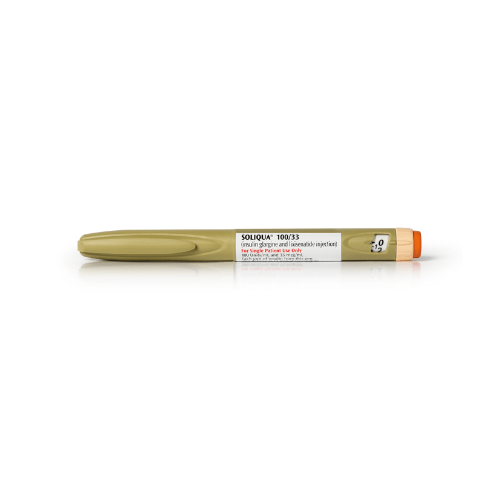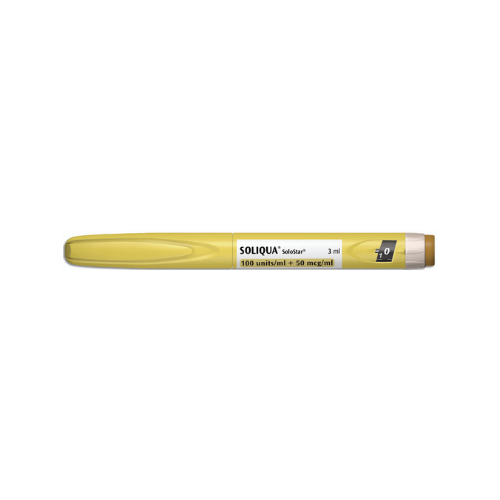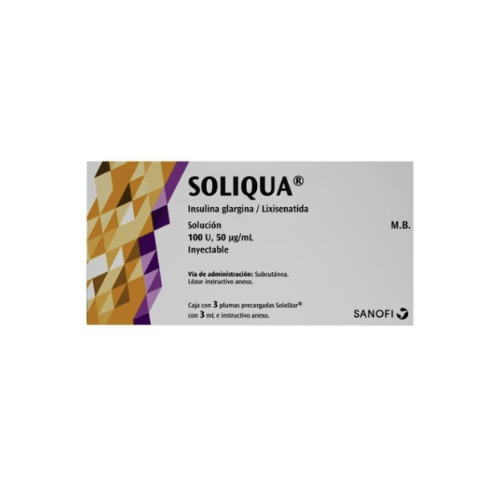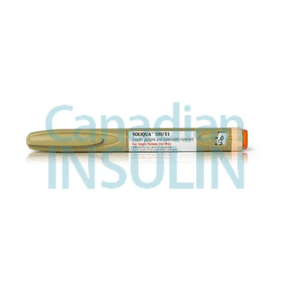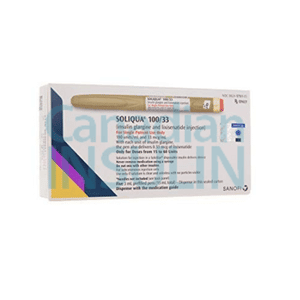Please note: a valid prescription is required for all prescription medication.
Soliqua® SoloStar is a once-daily fixed-ratio pen that pairs insulin glargine 100 units/mL with lixisenatide 33 mcg/mL to help control blood sugar in adults with type 2 diabetes. At CanadianInsulin, you can view Canadian pricing and place a mail-order from Canada with US delivery from Canada, including express, cold-chain shipping. This page explains how the pen works, who it is for, and how to use and store it, whether you pay cash or buy without insurance.
What Soliqua® Is and How It Works
Soliqua® 100/33 combines two glucose-lowering medicines in one prefilled SoloStar pen. Insulin glargine is a long-acting basal insulin that works through the day and night to control fasting glucose. Lixisenatide is a GLP-1 receptor agonist that helps the pancreas release insulin when glucose rises, reduces glucagon, and slows gastric emptying. Together, the combination targets both fasting and after-meal blood sugars with one dose.
CanadianInsulin connects patients with licensed Canadian pharmacies. Prescriptions are verified with your clinic before dispensing.
Soliqua is indicated as an adjunct to diet and exercise to improve glycemic control in adults with type 2 diabetes. It is not for type 1 diabetes or diabetic ketoacidosis. Do not use it with another GLP-1 receptor agonist or with lixisenatide as a separate medicine. It is a subcutaneous injection only and should not be given intravenously or via an insulin pump.
For a quick overview of this dual-action pen, see our article on the Soliqua Solostar Pen.
Who Soliqua® Is For
Soliqua is for adults with type 2 diabetes who need better control despite oral medicines, basal insulin, or a GLP-1 RA. It may be considered when fasting and post-meal glucose remain above targets and adding injections is appropriate. It is not recommended for people with type 1 diabetes or for the treatment of diabetic ketoacidosis. The pen is not approved for pediatric use. Caution is advised in patients with a history of pancreatitis or severe gastrointestinal disease, including gastroparesis, and in those with renal impairment. Patients with known hypersensitivity to insulin glargine or lixisenatide should not use Soliqua.
Dosage and Usage
Soliqua is injected once daily within the hour before the first meal of the day. Use the abdomen, thigh, or upper arm for subcutaneous injection, rotating sites to reduce skin changes. Do not mix or dilute Soliqua with any other insulin or solution.
Initial dosing generally follows the labeled approach:
- For patients on less than 30 units of basal insulin daily or those switching from a GLP-1 RA: typical starting dose is 15 units of Soliqua.
- For patients on 30 to 60 units of basal insulin daily: typical starting dose is 30 units of Soliqua.
Titrate the dose based on fasting plasma glucose, usually in small steps (for example, 2 to 4 units), until targets are reached. The maximum daily dose is 60 units. The pen delivers a combined dose where each unit contains both insulin glargine and lixisenatide in the fixed 100/33 ratio. Follow the dose your clinician prescribes and refer to the official label for complete instructions.
Strengths and Forms
Soliqua is supplied as a prefilled SoloStar pen containing insulin glargine 100 units/mL and lixisenatide 33 mcg/mL. Each pen contains 3 mL. Packs commonly include multiple 3 mL pens. Availability and pack size may vary by dispensing pharmacy.
If you are comparing injection devices for ongoing therapy, our Insulin Pens category provides additional options and formats.
Missed Dose and Timing
Inject Soliqua once daily within the hour before your first meal. If a dose is missed, skip the missed dose and take the next scheduled dose at the usual time. Do not take two doses in the same day. Keep a consistent time-of-day routine to support steady glucose control.
Storage and Travel Basics
Unopened pens should be stored in a refrigerator at 2°C to 8°C (36°F to 46°F). Do not freeze. Keep pens in their cartons to protect from light. In-use pens can be kept at room temperature (generally up to 30°C/86°F) or refrigerated. Discard a pen 28 days after first use, even if it still contains medicine. Keep away from heat and direct sunlight.
For travel, pack pens in an insulated case and keep them with your carry-on. Avoid direct contact with ice or gel packs to prevent freezing. Carry spare needles and a backup pen when possible. Our shipments use temperature protection and express, cold-chain handling.
Pen Handling and Sharps Disposal
Before each injection, read the Instructions for Use that come with the pen. General steps include:
- Check the label to confirm Soliqua 100/33.
- Attach a new sterile needle for each injection.
- Prime the pen per the Instructions for Use to ensure a proper flow.
- Select the prescribed dose on the dose selector.
- Inject into recommended subcutaneous sites and hold as directed.
- Remove and safely discard the needle after each use.
Never share pens or needles. Dispose of used needles in an FDA-cleared sharps container or a sturdy household container that meets local rules.
Benefits
Soliqua provides basal insulin and GLP-1 receptor agonist therapy in a single daily injection. This combination supports fasting and post-meal glucose control without multiple separate pens. The fixed-ratio design simplifies titration with unit-based dialing rather than separate calculations for two agents. For many adults, consolidation to one pen can reduce complexity while maintaining label-directed therapy.
Side Effects and Safety
- Common effects: nausea, vomiting, diarrhea, decreased appetite, headache, nasopharyngitis.
- Injection site reactions, itching, or mild redness.
- Hypoglycemia risk, especially when used with sulfonylureas or if meals are delayed.
- Potential dizziness or stomach discomfort.
Serious but less common risks include pancreatitis, severe allergic reactions, acute kidney injury (often related to dehydration from persistent nausea/vomiting), and gallbladder problems. Seek medical attention for severe abdominal pain, signs of anaphylaxis, or recurrent low blood sugar. People with a history of pancreatitis or severe gastrointestinal disease should discuss risks with their clinician.
Drug Interactions and Cautions
Medicines that lower blood glucose, such as sulfonylureas or other insulins, may increase the risk of hypoglycemia when combined. Beta-blockers can mask some symptoms of low blood sugar. Corticosteroids, certain antipsychotics, and some HIV medicines may raise blood glucose. Alcohol can increase the risk of hypoglycemia. Because lixisenatide slows gastric emptying, monitor the effect on oral medicines that require rapid absorption or have a narrow therapeutic index. Do not use Soliqua with any other GLP-1 RA.
If a basal-bolus regimen is chosen instead of a fixed-ratio combination, your clinician may prescribe a rapid-acting mealtime insulin. For background reading on such options, see the Apidra Solostar Pen article.
What to Expect Over Time
Clinicians often start with a lower Soliqua dose and adjust based on fasting glucose and overall patterns. Gastrointestinal effects, if present, commonly lessen with continued use. As the dose is titrated, many patients see steadier fasting values and fewer post-meal spikes. A1C improvements are typically evaluated over months, alongside diet, activity, and other medicines.
Compare With Alternatives
Other prescription options include separate basal insulin plus a mealtime insulin, or another fixed-ratio pen. A closely related alternative is the Xultophy® Prefilled Pen, which combines insulin degludec with liraglutide. For patients needing a different basal insulin profile, Toujeo® Doublestar Pen contains concentrated insulin glargine and may be considered if a clinician prefers basal-only therapy.
To understand basal dosing concepts, our editorial guide on Toujeo Dosage Guide offers practical context. Your prescriber will determine the most appropriate plan based on your goals, prior therapy, and tolerance.
Pricing and Access
CanadianInsulin lists Soliqua Solostar pens with Canadian pricing and US shipping. You can buy Soliqua Solostar pens online as a mail order from Canada and have them shipped to the US. Browse the Soliqua 100/33 pen price details on the product page, compare the Soliqua Solostar pens price to alternatives, and see if the insulin glargine lixisenatide pen fits your budget. Many patients check a Soliqua Solostar cash price for out of pocket or self-pay purchases. You can also purchase Soliqua Solostar 100/33 3 mL pens for refill when your clinic confirms your prescription.
Checkout is encrypted, and your order is pharmacy-dispensed. If you track discounts, visit our Promotions page for current offers. CanadianInsulin ships Soliqua Solostar from Canada to the US, and we support prompt, express, cold-chain shipping.
Availability and Substitutions
Availability can vary. If Soliqua is temporarily unavailable, a prescriber may recommend another therapy or a short-term substitution based on your history and current glucose control. Follow your clinician’s plan and the pharmacy’s guidance.
Patient Suitability and Cost Saving Tips
Soliqua may be suitable for adults with type 2 diabetes who need both basal insulin and GLP-1 RA effects with one daily injection. It is not for type 1 diabetes, ketoacidosis, or concurrent use with another GLP-1 RA. Individuals with severe gastrointestinal disease, prior pancreatitis, or significant kidney issues should review risks and benefits with their clinician.
Cost and convenience ideas:
- Ask your prescriber about a multi-month prescription to reduce shipping frequency.
- Set refill reminders so you always have an in-date pen ready.
- Store backup pens properly to avoid waste from temperature excursions.
- If your plan changes, discuss whether to continue the same pen or adjust therapy.
Questions to Ask Your Clinician
- Is Soliqua 100/33 appropriate based on my current A1C and fasting readings?
- What starting dose and titration steps should I follow?
- How will we monitor for nausea or signs of hypoglycemia?
- Should I stop my current GLP-1 RA or adjust other diabetes medicines?
- What is the correct injection technique and timing with my first meal?
- How should I manage sick days, travel, or changes to my eating routine?
- When should we reassess A1C and overall treatment goals?
Authoritative Sources
Start your order when ready for US delivery from Canada with express, cold-chain shipping.
Express Shipping - from $25.00
Shipping with this method takes 3-5 days
Prices:
- Dry-Packed Products $25.00
- Cold-Packed Products $35.00
Standard Shipping - $15.00
Shipping with this method takes 5-10 days
Prices:
- Dry-Packed Products $15.00
- Not available for Cold-Packed products
How do I use the Soliqua SoloStar pen?
Use a new needle each time, prime the pen per the Instructions for Use, dial the prescribed dose, inject subcutaneously within one hour before the first meal, hold the needle in place as directed, then remove and discard the needle safely. Do not share pens or needles.
What is the usual starting dose for Soliqua 100/33?
Adults switching from less than 30 units of basal insulin or from a GLP-1 RA often start at 15 units. Those on 30 to 60 units of basal insulin often start at 30 units. Your clinician will individualize dosing and titration.
Can Soliqua be used with mealtime insulin?
Soliqua combines basal insulin with a GLP-1 RA and is not used with another GLP-1 RA. Using mealtime insulin alongside Soliqua is not typically recommended; your clinician will decide if a basal-bolus plan is more appropriate instead.
What if I am switching from a GLP-1 RA to Soliqua?
Your clinician will advise stopping the other GLP-1 RA and starting Soliqua at a label-based initial dose, then titrating to target based on fasting glucose and overall control.
How should I store Soliqua pens?
Keep unopened pens refrigerated at 2°C to 8°C. Do not freeze. In-use pens can be kept at room temperature (up to 30°C) or refrigerated and should be discarded 28 days after first use. Protect from heat and light.
What are common side effects of Soliqua?
Nausea, vomiting, diarrhea, decreased appetite, headache, nasopharyngitis, and mild injection site reactions. Hypoglycemia can occur, especially with sulfonylureas. Seek medical help for severe abdominal pain, signs of allergy, or recurrent low blood sugar.
Does CanadianInsulin ship Soliqua to the US?
Yes. Orders are shipped from Canada to the US with express, cold-chain shipping after prescription verification with your clinic.
Rewards Program
Earn points on birthdays, product orders, reviews, friend referrals, and more! Enjoy your medication at unparalleled discounts while reaping rewards for every step you take with us.
You can read more about rewards here.
POINT VALUE
How to earn points
- 1Create an account and start earning.
- 2Earn points every time you shop or perform certain actions.
- 3Redeem points for exclusive discounts.
You Might Also Like
Related Articles
National Diabetes Education Week: Tools for Better Care
Every November, millions of people come together to raise awareness about diabetes, a condition that affects more than 38 million Americans. Among the month-long initiatives, National Diabetes Education Week stands…
Diabetic Eye Disease Month: Protect Your Vision Today
Vision is one of our most precious senses, yet millions of people with diabetes are at risk of losing it without even realizing it. According to the Centers for Disease…
Join the Cause: American Diabetes Month 2025
Every November, millions of Americans come together to shine a light on one of the country’s most pressing health challenges — diabetes. American Diabetes Month is more than just a…
Orforglipron vs Rybelsus: Which Is More Effective?
According to the International Diabetes Federation (IDF), around 589 million adults aged 20–79 are living with diabetes globally. This marks the need for immediate medical action and treatment. Fortunately, with…


